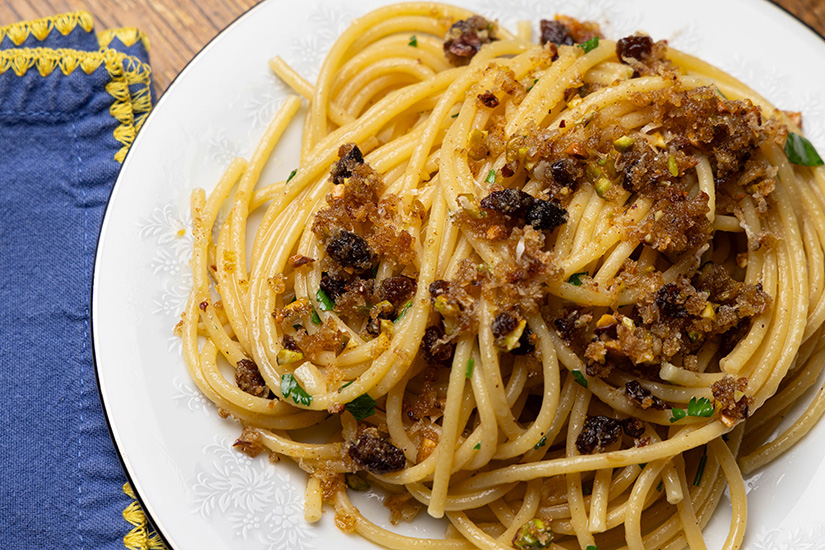 Bucatini aglio e olio with mudricaPhoto Credits: Teak Phillips
Bucatini aglio e olio with mudricaPhoto Credits: Teak PhillipsWith intricate bread altars and delectable foods, St. Joseph Altar celebrations around the saint’s March 19 feast day reinforce community and seasonality. Even though the feast day falls before our regional growing season, the celebration stems from the agricultural ebbs and flows of the harvest in rural Sicily. Agrarian life in the Middle Ages was a matter of faith. Similarly, the celebration reminds us that St. Joseph is our model of faith: He was just an ordinary person who reached salvation by putting God at the heart of everyday life.
St. Joseph Altar celebrations started when Sicilians prayed through the intercession of St. Joseph for God to send rain and end the droughts that parched their fields. When God answered their petitions, the people of the island praised Him and honored St. Joseph. The feast day celebrations have incorporated many food traditions, such as bread sculpted like wheat as a symbol of the harvest. Some of the traditions come from immigrants who settled in the United States.
The altars have many forms in numerous locations, including homes and church halls. The altar’s centerpiece is the bread, which might include traditional loaves, fig cakes, colorful biscotti and bread sculptures in the shape of a staff or fish. Other traditional adornments are lilies, pasta, seafood, statues and “lucky” fava beans.
In the cookbook “Mama’s Kitchen,” Donna M. D’Arcangelo identifies pasta Milanese, cuccidati (fig pastries) and stuffed artichokes as traditional foods for the altars in New Orleans. The altars range from multi-family gatherings to a simple home altar with a St. Joseph statue, a bottle of wine and a bowl of citrus.
No matter an altar’s size or ornateness, the feast’s essence is community. The Sicilian community came together to survive a drought. Modern Catholic communities come together at altars to leave petitions, to generously feed each other and reinforce our covenant with God by offering humble sacrifices to glorify Him.
The St. Joseph Altar is popular in areas with significant Italian heritage. St. Ambrose Parish will celebrate its annual St. Joseph Altar on Sunday, March 17.
Joshua Galliano is a parishioner at St. Barbara in Okawville, Illinois, and is the innovation leader at Companion Baking.
Bucatini Aglio e Olio
1 lb dried bucatini (or spaghetti)
1/3 cup extra virgin olive oil
6 to 8 cloves garlic, minced
½ - 1 tsp chili flakes
½ cup Italian parsley, roughly chopped
Salt and pepper, to taste
1. Bring a large pot of salted water to a boil over high heat. Add the bucatini to the boiling water and use tongs to stir the pasta to prevent sticking. Reserve one cup of the pasta water. Cook the pasta until it is al dente, then drain.
2. While the pasta is cooking, heat a large skillet over medium heat. Add the olive oil. When the oil is hot but not smoking, add the minced garlic. Cook the garlic until it becomes fragrant and begins to brown, about 1 to 2 minutes. Add the chili flakes and the reserved pasta water to the pan, then add the cooked pasta. Swirl the pasta around the pan.
3. Turn off the heat. Add the chopped parsley and stir with the pasta to distribute everything. Taste the pasta and adjust the seasoning with salt and pepper to taste.
4. Serve the pasta topped with Mudrica.
Mudrica
½ cup bread crumbs (from day-old rustic bread)
3 Tbsp extra virgin olive oil
3 Tbsp unsalted butter
3 Tbsp parmesan, grated
2 Tbsp pistachios, chopped
2 Tbsp raisins, chopped
A pinch of chili flakes
¼ tsp cinnamon
A pinch of salt
A pinch of oregano or basil
1. In a small skillet over medium heat, combine the butter and olive oil. Heat until the butter begins to foam, then turn off the heat.
2. Combine everything in a bowl. Reserve until ready to serve the pasta.